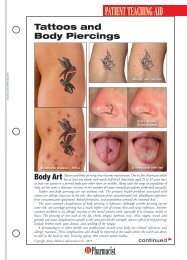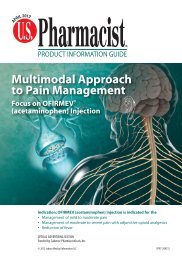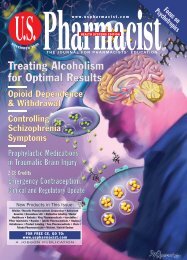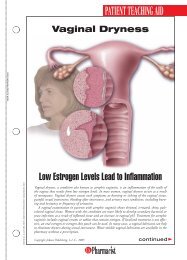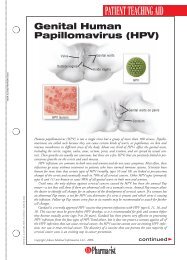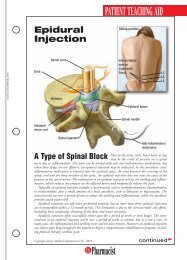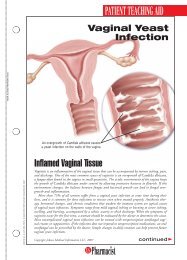Dry Eye - PharmQD
Dry Eye - PharmQD
Dry Eye - PharmQD
Create successful ePaper yourself
Turn your PDF publications into a flip-book with our unique Google optimized e-Paper software.
LacrimalglandsPATIENT TEACHING AID<strong>Dry</strong> <strong>Eye</strong>Drainage canalsTEAR ALONG PERFORATIONMeibomianglandsConjunctivaCorneaInsufficientProduction of TearsTear flowTear ductCorneaTEAR FILMOily layer(meibomianglands)Watery layer(lacrimalglands)Mucus layer(epithelial cells)Tears are important for the health of the eye. They bathe the cornea—the clear outer surface of theeye—keeping it moist, comfortable, and clean. Tears also protect the eye from infection.When fewer tears are produced to keep the eye comfortably lubricated, or when tears are notmoisturizing enough and dry up quickly, a condition known as dry eye syndrome can result. <strong>Dry</strong>eye is often an occasional problem for people who stare for long periods at a computer screen ortravel frequently by airplane. It can also be one of the symptoms of an autoimmune disease, suchas lupus, rheumatoid arthritis, or Sjögren’s syndrome. Many people complain of the symptoms ofdry eye as they grow older, since tear production decreases with age. Many drugs, including hormones,antihypertensive medications, decongestants, and antihistamines, can cause dry eye. Certaineyelid problems that interfere with blinking can also lead to dry eye.Symptoms of dry eye may occur occasionally or may be a chronic condition. Some of the morecommon symptoms are irritation, burning, pain, redness, itching, fuzzy vision, and stringy mucusin the eye.Treatment for dry eye begins by determining the cause of the problem. The first step is toeliminate any treatable cause, such as allergies or medications. Avoiding environments or situationsthat exacerbate dry eye is helpful. There are many artificial tear eyedrops, eye ointments, and eyegel inserts available to increase lubrication. These products may be helpful in mild or moderatecases of dry eye syndrome. Patients with severe dry eye syndrome who cannot be treated by othermeans may be candidates for punctal plugs, which are small, removable plugs in the tiny drainageholes at the inner corners of the eyelids where tears drain. Plugging these drainage holes help increasethe amount of tears that moisturize the cornea.Copyright Jobson Medical Information LLC, 2010 2011continued
PATIENT TEACHING AIDCauses Range FromAging to Certain Drugsto Environmental FactorsCorneaTEAR FILMOily layer(meibomianglands)Watery layer(lacrimalglands)<strong>Dry</strong> eye can be mild or severe, and symptoms can be occasionalor chronic. There are many causes of dry eye syndrome, includingsystemic diseases, drugs, and aging. The condition is morecommon in women, especially postmenopause. There are alsoseveral eye problems that can lead to dry eye syndrome,Mucus layer(epithelial cells)Tears are composed of three layers,each layer produced by different glands,so a problem with any of those sourcescan result in dry eye.including inflammation of the eyelids. People who live or work in dry environments or whostare for long periods of time without blinking are at higher risk for developing dry eye.Diagnosing <strong>Dry</strong> <strong>Eye</strong> SyndromeThe diagnosis of dry eye syndrome is made using a history of symptoms, visual inspection ofthe eye, and tests to determine if the amount of tears and their moisturizing ability are adequate.An optometrist can use simple office tests to make a rough estimate of the amount of tearsproduced, how well they cover the cornea, and the time it takes for tears to evaporate.Contact lenses may be a problem for people with dry eye syndrome. The type of lens orlength of wear time may need to be adjusted to increase eye moisture. Contact lenses may notbe an option to correct vision in some cases of chronic dry eye.Moisturizing <strong>Eye</strong>drops Relieve SymptomsTreatment for dry eye depends on the severity of the condition and its cause. If a cause canbe identified and treated, dry eye syndrome can often be improved. Inflammation of theeyelids may relieved by placing a warm washcloth over the eyes for a few minutes, then washingthe eyelids with a mild soap or special cleanser recommended by an eye care professional.In mild cases of dry eye, moisturizing eyedrops or eye ointments can give relief. Nonprescriptioneyedrops that simply lubricate the cornea are available with preservatives or in single-usepackets that are preservative free. These moisturizing eyedrops are best without preservativesif they are used more than four times a day. <strong>Eye</strong> ointments often blur vision, so they are bestused before bedtime. A twice-daily prescription eyedrop of cyclosporine can oftentimes relievedry eye due to inflammation of the cornea. Antibiotic or corticosteroid eyedrops may berequired for a short period if the eyelids are inflamed.In severe cases, when eyedrops or ointments are not sufficient to provide lubrication, a tinyeye gel insert can be placed inside the lower lid once a day. The insert slowly dissolves, lubricatingthe eye throughout the day. Punctal plugs as a temporary measure or a more permanentsurgical closure of the tear duct drainage holes is sometimes necessary to retain sufficient tearsin the eyes.Simple lifestyle changes can also help improve symptoms of dry eye syndrome. These includewearing wrap-around sunglasses in the wind, increasing the humidity levels at home, takingbreaks when staring at the computer, and avoiding drafts that blow directly on the face wheneverpossible.If you have questions about dry eye syndrome or the OTC or prescription eyedrops usedto treat this problem, ask your pharmacist. Your pharmacist can also show you how to properlyinsert eyedrops, gels, or ointments.




